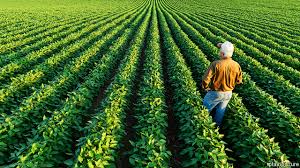"We've been gambling up to this point," says Tim Bardole, a soyabean farmer from Iowa.
“到目前为止,我们一直在赌,”蒂姆·巴多尔,一名来自爱荷华州的豆农说到。
After the price of soyabeans crashed last summer, he held on to most of his harvest and waited for the market to recover.
自去年夏天大豆价格暴跌后,他留下了自己的大部分大豆收成,等着市场恢复。
But seven months later, and with large loans to repay, he sold up. "We decided we'd better take what we have," he says.
但是七个月后,他偿还完大额贷款便把手头的大豆都卖掉了。“我们认为我们最好是见好就收。”他表示。
The cause of the crash was a 25% tariff on American soyabeans imposed by China, the world's biggest importer,
价格暴跌的原因是美国对出口中国的大豆征收25%的关税,中国是世界最大的进口国,
as one shot in the trade war between the two countries. Yet peace is supposedly in the offing.
这是美国在两国贸易战中的一击。但据推测和平即将来到。
The two countries are locked in negotiations over a deal, ahead of a deadline of March 1st that has been imposed by America
美国定于3月1日对中国产品加征关税,但在此期限之前两国仍在为达成一份协议进行谈判,
(though on February 19th President Donald Trump declared the timing to be flexible).
(虽然2月19日,唐纳德·特朗普总统宣布时间有所变动)。

That Mr Bardole cut his losses despite those talks is not that surprising.
尽管两国进行多次对话,但巴多尔赶紧脱手以免多受损失的做法并不奇怪。
Even if the tariff is lifted—which is far from certain—the past year's disruption will probably leave a permanent scar.
虽然免除了关税—目前并不能确定—但之前的破裂可能留下永久的伤疤。
The trade war caught American soyabean farmers at a particularly bad time.
贸易战争找上美国大豆农民的时机很糟糕。
They had just planted a bumper crop, encouraged by strong demand and a drought in Argentina, a competitor.
受竞争对手阿根廷干旱和需求强劲的鼓舞,他们刚刚种下了大批丰产作物。
When the tariff was implemented it was too late to switch to other crops such as corn.
关税实施时,转种其他作物,如玉米,已经太晚了。
Demand from China—which in 2017 accounted for 60% of American exports—collapsed. The result was a glut.
中国的需求—2017年中国需求占美国出口的60%—暴跌。结果大豆供过于求。
To replace American beans China has ramped up its imports from Brazil, pushing up prices in South America.
为了替换美国大豆,中国已经增加了从巴西的进口,推高了南非大豆的价格。
Meanwhile the European Union, Mexico and even Argentina have been tempted by low American prices—but not enough to replace lost Chinese demand.
同时,欧盟、墨西哥,甚至是阿根廷都被美国大豆的低价所诱惑—但这还不足以弥补中国需求的损失。
To help American farmers cope, Mr Trump's administration handed them a one-off payment of $1.65 per bushel ($61 per tonne).
为了帮助美国农民,特朗普政府为他们提供了每蒲式耳1.65美元的一次性付款(每公吨61美元)。
Without it Mr Bardole would have lost money on this year's crop.
没有这次补助,巴多尔今年的农作物会亏本。
He might have sold his crop anyway, but the support has allowed others to sit on theirs.
不管怎样他可能已经卖掉了自己的农作物,但其他人压下了自己的农作物。
Farmers will have 25m tonnes of beans in stock at the end of this year's selling season, according to an official estimate, up from 12m tonnes last year.
根据官方估计,今年销售旺季末,农民们将储存有250万公吨的豆子,多于去年的120万公吨。
译文由可可原创,仅供学习交流使用,未经许可请勿转载。



